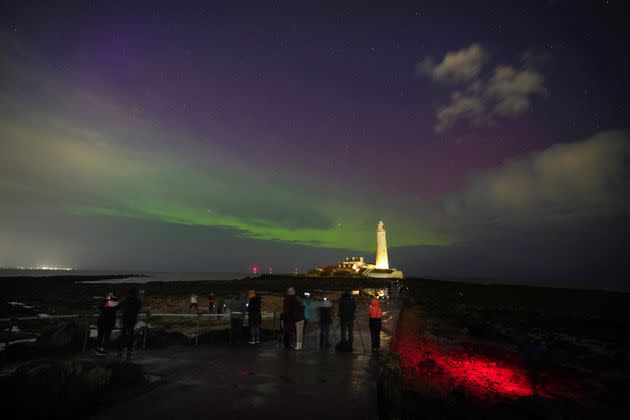Here's Where You'll Be Able To See The Northern Lights Tonight In The UK

The aurora borealis, also known as the northern lights, glow on the horizon at St Mary's Lighthouse in Whitley Bay on the North East coast, March 23, 2023.
The Northern Lights are going to be visible from parts of the UK tonight and tomorrow night, just one month since they last popped up.
There is a catch though – while in February, the Aurora Borealis was visible all over the country, including in Kent and Cornwall, this time it’s only north Scotland who will be able to see the show.
The Met Office explained that the natural phenomenon, which causes a range of different colours to span the sky briefly, will be visible both on Thursday March 30 and Friday March 31 (as long as there are no clouds of course).
If all goes to plan, they should be visible from around 6.30pm, particularly in places of low light pollution.
This is all because of a new “hole” on the surface of the Sun, which has triggered solar storms with winds at nearly 500 miles per second launched into space.
This is a fairly common phenomenon, but this one is particularly interesting because it’s pointed towards Earth. And Nasa’s Solar Dynamics Observatory found that this hole is 20 times larger than our planet.
While it may sound scary, it’s not dangerous. Also known as a coronal hole, it just means there’s a large dark area in the atmosphere that is cooler than its surroundings.
However a separate event, a fast solar wind from a coronal hole, means minor solar storms are possible on Thursday and Friday night.
This means aurora sightings would be possible in northern Scotland under clear skies.
Space Weather forecast is here 👇https://t.co/h3j6WqzHYZ— Met Office Space (@MetOfficeSpace) March 29, 2023
Sometimes these storms can damage satellites and power infrastructure, but forecasters aren’t expecting that with this one.
In fact it’s because this storm is so small that people in the south of the UK won’t get to see the spectacle.
The Met Office Space Weather Operations Centre’s Krista Hammond explained: “Minor solar storms are possible on Thursday and Friday night, which means aurora sightings would be possible in northern Scotland under clear skies.
“As this is a fairly minor solar storm, the auroras aren’t expected to be visible much further south on this occasion.”
Hammond continued: “This is expected to be a G1 solar storm, which is the lowest category for these events and the most frequent events we see.”
Related...
Here's The Exact Time You Can See The Northern Lights Across The UK Tonight
Green Comet To Be Visible With The Naked Eye For First Time In 50,000 Years
Why Do We Celebrate Winter Solstice – And What Meaning Does It Hold?

